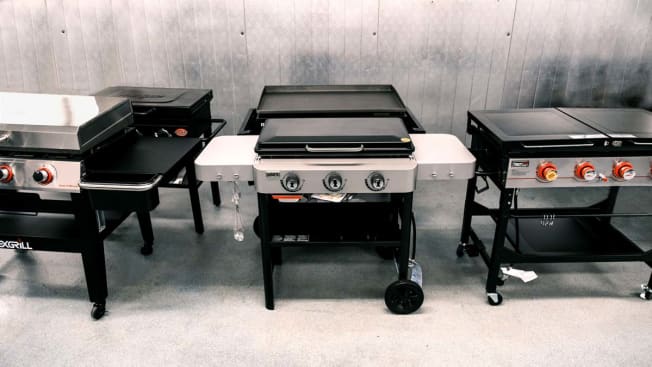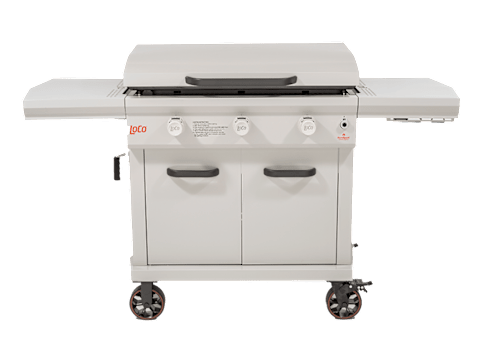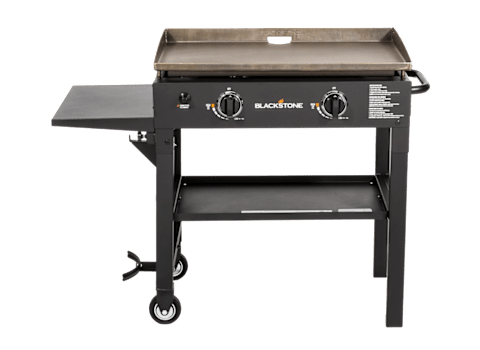They transform your yard into a full-service kitchen by cooking everything your regular grill can’t—but some are more capable than others

In Consumer Reports' grill lab, flat-top grills are queued up for temperature testing.
By Paul Hope
What do fried eggs, skinny asparagus, and a grilled cheese sandwich all have in common? They’re delicious, yes, but they’re all also absolutely disastrous to cook on a regular grill. Enter the flat-top grill.
Also called a flat-top griddle, these outdoor cooking appliances fill in the gaps—literally and figuratively—that your regular grill leaves open. And while Blackstone put flat-top grills on the map, our testers find that you have plenty of other good options—including those from brands you may have never heard of, offering even better performance, and a nicer package, albeit at a higher price.
While a flat-top grill looks a lot like a typical gas grill, it boasts a flat, seamless metal cooking surface in lieu of grill grates. The result? A tool that can cook just about anything, without the user worrying about small, narrow, or runny items falling through the gaps.
“A flat-top grill is often used for breakfast foods, like pancakes, bacon, eggs, or home fries,” says Mark Allwood, CR’s senior market analyst in charge of grills. They can also be stellar for burgers and hot dogs, but also veggies that are otherwise prone to falling through grates, like sliced onions or strips of bell peppers. “But keep in mind that they’re meant to supplement, not replace, a regular grill.”
That’s because there are certain foods or cooking styles that will simply always be best on a grill, like anything you’re trying to char, or if you want to cook with wood chips or chunks for smoky flavor. (To learn more about what kind of grill might be best for your needs, see our grill buying guide; to explore how grills of all types perform in our tests, see our comprehensive grill ratings.)
What’s the Difference Between a Flat-Top Grill and a Griddle?
The terms are often used interchangeably, but in the grilling world, a griddle is typically an accessory to be used with your regular grill, while a flat-top grill is a separate freestanding appliance. A flat-top grill gets connected to a propane canister, generates a hidden flame, and distributes the heat from that flame across a metal cooking surface. A griddle is just a flat piece of metal (or a pan) that you place onto your grill. A flat-top grill can hold far more food than a griddle accessory for a grill. It’s also easier to regulate temperature, and in turn, get better results, because a griddle lets you fine-tune temps without transferring heat to a separate pan.
So is a flat-top grill worth it? The answer comes down to how much you enjoy cooking outdoors and for a crowd. You can cook a steak over your gas or charcoal grill, for instance, and use a flat-top grill for eggs, pancakes, and home fries to make a farmer’s breakfast. Or if you’re into camping or tailgating, a flat-top grill might make more sense than a regular grill because you can cook a broader array of foods without the need for extra grill accessories, like a griddle.
How Consumer Reports Tests Flat-Top Grills
In our lab, we wire the surface of each flat-top grill with thermocouples and perform four temperature tests. We record thousands of temperatures on each flat top. For preheat performance, we measure how hot the surface gets at the 10-minute mark because that’s when our data says most folks like to start cooking.
We also assess how evenly each model heats—if you’re cooking a giant batch of pancakes, you want them to finish at the same time. That’s a test we perform on both high- and low-temperature settings. Lastly, we size up indirect heating to see how well each flat-top grill can moderate heat, for those times you want to sizzle sunny-side-up eggs on high, and cook burn-prone foods like bacon at the same time.
How We Picked the Best Flat-Top Grills
The experts at Consumer Reports zero in on flat-top grills that are capable of cooking a great meal with consistent results. Here’s what the top models have in common:
- They heat reasonably quickly. The best flat-top grills reach 300° F, or close to it, within 10 minutes. That’s plenty for low-heat tasks like rendering bacon. This capability suggests that the grill can hit even higher temperatures soon after that, too, so you can start tasks like frying eggs or searing burgers.
- They heat evenly. The appeal of a flat-top grill is that you can cook lots of similar items at once. But it needs to heat evenly from one spot to another, in order to ensure consistent results. These models, with a width of 28 to 36 inches, are capable of doing that from edge to edge.
- They cook well on high and low. By design, flat-top grills don’t have as wide a temperature range as that of a regular gas grill. Nevertheless, these models are able to cook food evenly on both low- and high-heat settings, which often vary by a hundred degrees or more.
Best Flat-Top Grills
LoCo 36" 2023050166

CR’s take: The 36-Inch LoCo 3-burner flat-top grill is the best model we’ve tested. It heats evenly and offers the broadest temperature range of any model we’ve seen, so you can cook crispy fried eggs or slow-cook scrambled without burning them. It doesn’t heat up as quickly as the Blackstone, but it doesn’t keep you waiting for too much longer, either. It has a unique chalk-white finish and special burners that automatically cycle on and off—allowing the grill to maintain your selected temperature consistently across the cooking surface.
This LoCo is the largest of our top-scoring models, so it holds more food, too. It has a storage cabinet with double doors beneath the cooking surface and two side shelves. All in all, it’s the best model if you’re serious about cooking outdoors and willing to pay top dollar for top performance.
Weber Griddle 28" 43310201

CR’s take: This Weber flat-top grill looks like a trimmed-down version of the LoCo, above—at a little more than half the price. It lacks a cabinet or doors, and, instead, features an open cart. But it performs almost as well as the LoCo in terms of even heating and providing a good temperature range. And like the LoCo, it’s not the fastest to heat, but it’s reasonable. This Weber has three burners and, at 28 inches wide, a profile that’s about 8 inches narrower than the LoCo, so it can’t hold quite as much food.
Overall, it’s a stellar option if you cook for up to about 10 people at a time, and you value strong performance but don’t want to spend a fortune on a supplemental grill.
Blackstone 28" 1517

CR’s take: Blackstone all but built the category of outdoor flat-top grills. This entry-level model proves you don’t need to spend a ton to get great performance from its products, either. It’s about the same size as the Weber, above, but it’s the fastest of the models in this roundup to get hot. It maintains even temperatures across the surface on both low and high heat. And it’s the lone model here to feature only two burners, not three; as a result, you might have a slightly harder time maintaining two drastically different temperatures on the surface at once.
The griddle is built on an unassuming open cart, and it features only one side shelf. Still, while this grill is light on features and lacks the finish or polish of pricier picks, it’s a strong performer at an unbeatable price.
Consumer Reports is an independent, nonprofit organization that works side by side with consumers to create a fairer, safer, and healthier world. CR does not endorse products or services, and does not accept advertising. Copyright © 2023, Consumer Reports, Inc.
